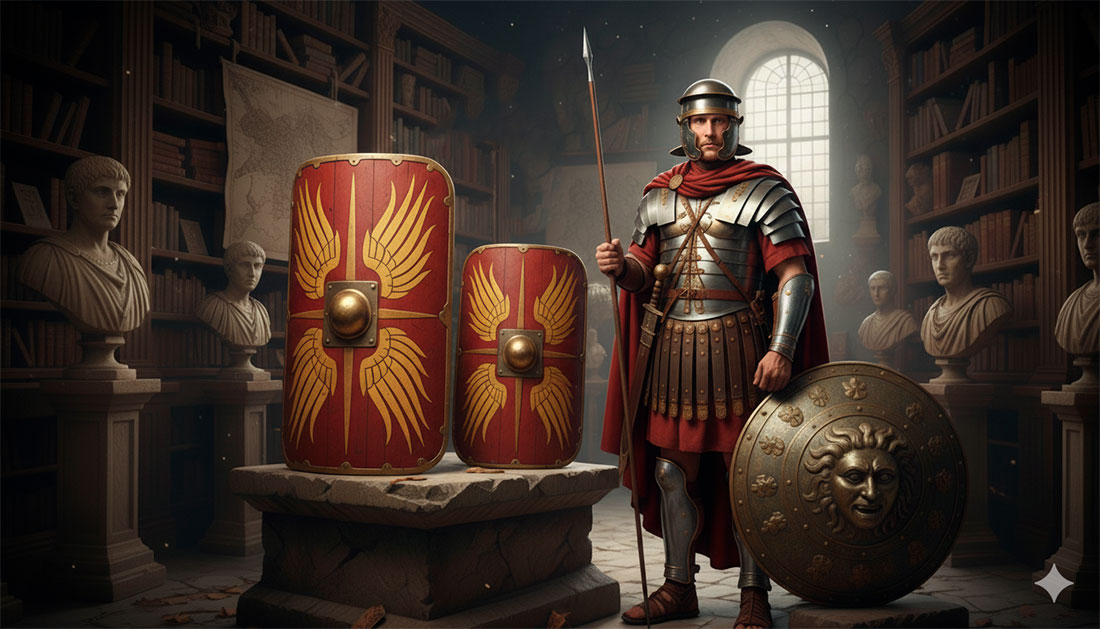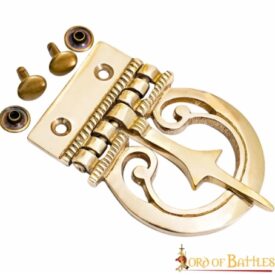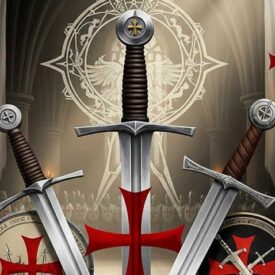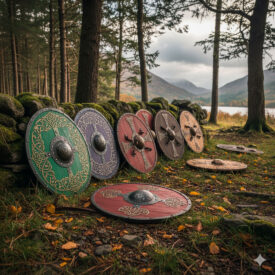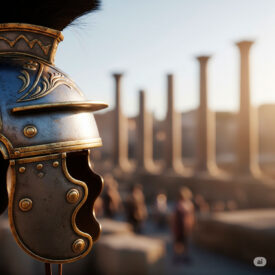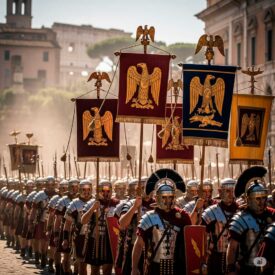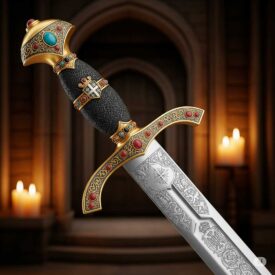Have you ever wondered how a simple piece of wood and metal could forge one of the greatest empires in history? The answer lies in the heart of the Roman legion: their shields. They were not mere defensive objects, but the embodiment of discipline, strategy, and the very life of each legionary. A symbol of an era when bravery on the battlefield was measured not only by the sword, but also by the unbreakable barrier a shield offered.
From the early days of the Republic to the twilight of the Empire, Roman shields evolved, adapting to each new threat and each change in combat tactics. But what were these shields and which of them was the faithful companion of a legionary? Let’s delve into the fascinating world of Roman protection, discovering how these pieces not only saved lives, but also allowed for the construction of legends.
The Fortress of Wood and Steel: Types of Roman Shields
The Roman army, a war machine without equal, did not rely on a single type of shield. Its effectiveness lay in specialization, and each unit, from heavy infantry to light cavalry, had a shield designed for its specific purpose. This adaptability is key to understanding Rome’s military dominance.
| Name | Shape and Characteristics | Typical Use / Period |
|---|---|---|
| Clipeus | Round or oval shield, made of wood or wicker, reinforced with bronze. Approximate diameter of 90 cm. | Used by the first Roman soldiers during the Monarchy and the beginnings of the Republic. Ideal for static phalanx formations. |
| Republican Scutum | Originally oval and curved (convex). Large size, covered from shoulder to knee. Made of two glued boards, covered with linen and calfskin, with an iron rim. | Main shield of the legionary heavy infantry during the Middle and Late Republic (late 3rd century BCE to 1st century BCE). The Kasr el Harit Shield is an example. |
| Imperial Scutum (Rectangular and Curved) | Rectangular and semi-cylindrical (or “tile-shaped”) form. Evolution of the oval scutum, the top and bottom sides were trimmed. | The most characteristic shield of the legions during the High Empire (primarily from the 1st century CE to the 3rd century CE). Emblem of legionary discipline. |
| Kalkriese Scutum | Transition model between the Republican scutum and the Imperial tile-shaped one. Estimated weight: 5.2 to 5.5 kg. | Used during the Augustan period (c. 9 CE). |
| Dura Europos Scutum | Almost complete example of a late rectangular scutum of the “tile” type. 105.5 cm high by 41 cm wide, three layers of wood. Thickness: 5 cm; estimated weight: 5.5 kg. | Discovery from the mid-3rd century CE, confirming the continuity of the model. |
| Parma | Round shield, smaller and flatter than the scutum. Approximately 89 cm in diameter. Wood with leather covering and iron boss (umbo). | Used by cavalry, light troops (velites, auxiliaries), and standard-bearers (signifers, aquilifers). |
| Parmula | Diminutive of parma. Small circular shield. | Used by legionary standard-bearers to facilitate handling the ensign and by **gladiators**. |
| Late Imperial Scutum (Oval/Round, Flat) | Oval or round, flatter and lighter shields. | Imposed from the second half of the 3rd century CE, used by mobile infantry (comitatenses). Adapted to interlocking shield tactics (synaspismós). |
- Early Circular and Oval Shields
-
- Clipeus: Round or oval shield, made of wood or wicker, reinforced with bronze. Used in the Monarchy and early Republic, ideal for phalanx-type formations.
- Republican Scutum: Oval, curved, and large, covered from shoulder to knee. Made of glued boards, linen, calfskin, and an iron rim. Used by legionary heavy infantry in the Middle and Late Republic.
- The Classic Imperial Scutum
-
- Imperial Scutum (Rectangular and Curved): Rectangular and semi-cylindrical (“tile-shaped”) form. The most characteristic of the legions of the High Empire (1st-3rd centuries CE), a symbol of their discipline.
- Kalkriese Scutum: Transition model, used in the Augustan period.
- Dura Europos Scutum: A late rectangular scutum, of significant height and with multiple layers of wood, estimated weight at 5.5 kg.
- Shields of Light Troops and Cavalry
-
- Parma: Round, smaller and flatter than the scutum. Used by cavalry, light troops (velites, auxiliaries), and standard-bearers.
- Parmula: An even smaller parma, used by standard-bearers and gladiators.
- Late Imperial Scutum (Oval/Round, Flat): Lighter and flatter, used by mobile infantry of the Low Empire and adapted to new tactics.
The Legionary’s Shield: More Than an Object, a Companion in Battle
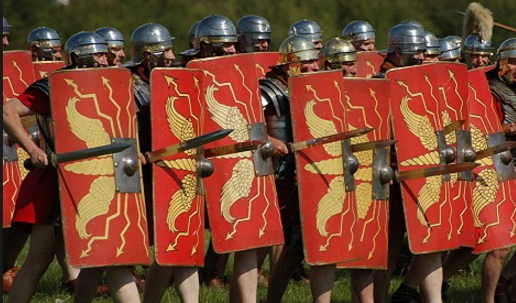 When you think of a Roman legionary, what image comes to mind? Probably a formidable warrior, armed with a gladius and protected by an imposing shield. And it’s not an illusion. The Scutum was, undoubtedly, the most iconic defender of the legionary.
When you think of a Roman legionary, what image comes to mind? Probably a formidable warrior, armed with a gladius and protected by an imposing shield. And it’s not an illusion. The Scutum was, undoubtedly, the most iconic defender of the legionary.
This was no ordinary shield. The scutum, especially in its rectangular and semi-cylindrical form of the High Empire, was a true portable fortress. Constructed with several layers of light and resistant wood, reinforced with metal edges and covered with leather or fabric, it offered almost invulnerable protection. Its curvature was not accidental; it allowed legionaries to join in formations as fearsome as the Testudo (turtle), an impenetrable barrier that advanced under a hail of projectiles. Its size, covering from shoulder to knee, made each legionary a vital piece of a moving defensive wall.
But the scutum was not just for defense. In its center, a metal **umbo** not only protected the legionary’s hand, but also became an offensive weapon, capable of striking and unbalancing the enemy in brutal hand-to-hand combat. It was the blunt blow that opened the guard before the gladius did its work.
Evolution of the Roman Shield Throughout History
The shape and function of the Roman shield did not stagnate. Like the Empire itself, it constantly evolved, adapting to the demands of each period and the changing nature of conflict. Understanding this evolution is to understand Rome’s military adaptability:
Archaic Period (8th–4th centuries BCE)
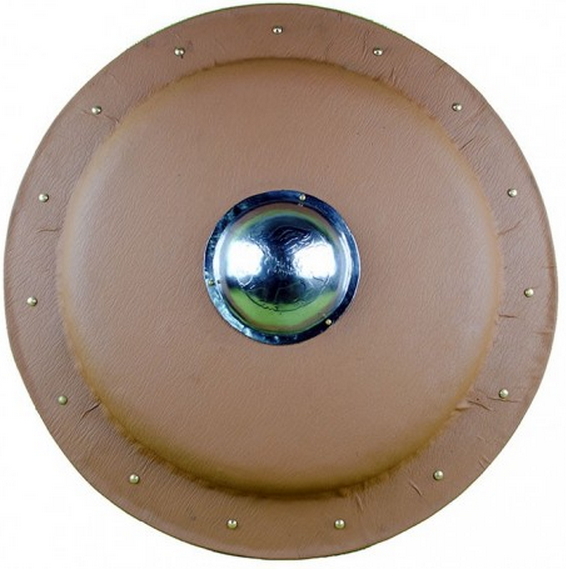
At the dawn of Rome, during the monarchy and early republic, Roman warriors wielded round shields, the **Clipeus**, reminiscent of Greek hoplites. Those were the days of less organized combat, where individual protection was paramount. By the 4th century BCE, Italic and Etruscan influence began to forge oval and curved shields, precursors of the legendary scutum.
Republic (3rd–1st centuries BCE)
The Second Punic War (late 3rd century BCE) marked the generalization of the **Oval and Curved Scutum**. Giant in size, it offered almost total coverage to the legionary, from shoulders to knees. Constructed with laminated wood, linen, and leather, and reinforced with metal edges, it proved to be as effective in protection as in the strategy of closed formations. Its design, which barely varied for almost two centuries, is a testament to its tactical perfection for the era.
High Empire (1st century BCE – 2nd century CE)
With Augustus’s military reforms, the **Rectangular and Semi-cylindrical Scutum** reached its peak. Larger and heavier than its predecessors, it covered almost the entire legionary. Its construction with glued wooden rods, lined with fabric and leather, and often decorated with the imperial symbols of the legion, made it the emblem of Roman power. The central **umbo**, now more pronounced, not only protected, but was also a key offensive weapon in close combat.
Late Empire (3rd–5th centuries CE)
 From the 3rd century CE onwards, the changing threat of an expanding empire led to the evolution of the scutum towards a lighter and more compact design. It lost part of its lateral curvature and narrowed, prioritizing **mobility**. With reinforcements at the corners and an umbo that could be circular or rectangular, this late shield also saw the resurgence of oval and circular shields (**Parma**), adapting to the growing importance of cavalry and the new tactics of the overburdened legions.
From the 3rd century CE onwards, the changing threat of an expanding empire led to the evolution of the scutum towards a lighter and more compact design. It lost part of its lateral curvature and narrowed, prioritizing **mobility**. With reinforcements at the corners and an umbo that could be circular or rectangular, this late shield also saw the resurgence of oval and circular shields (**Parma**), adapting to the growing importance of cavalry and the new tactics of the overburdened legions.
Clarifying doubts about the Roman shield
What was the main difference between the Republican scutum and the Augustan scutum?
The main difference between the Republican scutum and the Augustan scutum lies in their design and shape. The Republican scutum had a vertical spindle-shaped protrusion running down the center of the shield, aligned with the umbo (central metal piece). On the other hand, the Augustan scutum, implemented during Augustus’s imperial army reforms, abandoned this central protrusion and adopted a rectangular and semi-cylindrical shape, which facilitated its use in structured combat formations. Additionally, the Augustan scutum was made of several layers of light and resistant wood, and its surface was convex, which gave it greater robustness and protection against thrown weapons.
How was the umbo used in combat?
The umbo was a metal piece located in the outer center of the shield, primarily designed to protect the wearer’s hand and reinforce the shield’s structure. However, in combat it also had an offensive function: the soldier could strike the enemy with the umbo’s protrusion, using it as a blunt weapon in hand-to-hand combat, especially in close-quarters situations where the sword was not enough. This technique allowed legionaries or medieval warriors to maintain defense with the shield and, at the same time, deliver quick and direct blows by taking advantage of the umbo’s weight and hardness.
What materials were used to make Roman shields?
Roman shields, especially the scutum, were primarily made with several layers of light wood (such as willow, poplar, lime, birch, elder, or alder) glued together to provide strength and flexibility. This wooden structure was reinforced by covering it with linen, lamb’s wool felt, or bovine leather, which helped maintain the integrity of the assembly and absorb impacts. The edge of the shield was usually protected with bronze or iron fittings, and a metal umbo (usually iron or bronze) was placed in the center, serving both as additional protection and as a grip. The backside had a transversal handle, often made of wood or metal, lined with leather to improve grip and, in some cases, internal padding was added for greater comfort and protection. The outer surface could be painted with vivid colors and decorations, but the fundamental structure combined wood, leather, fabric, and metal. Occasionally, a thin sheet of bronze or iron was added to the surface for greater durability.
What type of shield did the velites and hastati use?
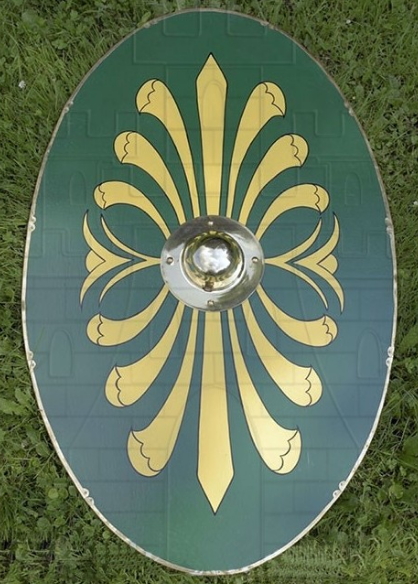 The velites used a small round shield called a parma, approximately 90 cm in diameter, designed to be light and practical for their role as light infantry and skirmishers. In contrast, the hastati, who were heavy infantry in the Roman legion, used a larger and more robust oval or semi-rectangular shield called a scutum, which covered a large part of the body and served both for protection and to form a defensive wall in battle.
The velites used a small round shield called a parma, approximately 90 cm in diameter, designed to be light and practical for their role as light infantry and skirmishers. In contrast, the hastati, who were heavy infantry in the Roman legion, used a larger and more robust oval or semi-rectangular shield called a scutum, which covered a large part of the body and served both for protection and to form a defensive wall in battle.
Thus, the main difference is that the velites had a small, round parma for greater mobility, while the hastati carried a large, curved scutum for more complete defense.
How did the design of the Roman shield evolve over time?
Evolution of the Roman Shield Design
Archaic Period (8th–4th centuries BCE)
In the era of the monarchy and early republic, Roman soldiers used round shields (clipeus) similar to those of the Greeks, suitable for disorganized combat. From the 4th century BCE, the influence of Italic and Etruscan models is perceived, with oval and curved shields anticipating the future scutum.
Republic (3rd–1st centuries BCE)
During the Second Punic War (late 3rd century BCE), the use of the oval and curved scutum became widespread, designed for closed infantry formations. This piece, made of laminated wood, linen, leather, and metal edges, proved effective in both protection and production. The fact that its morphology barely evolved for almost two centuries indicates its optimal adaptation to the tactics of the time.
High Empire (1st century BCE – 2nd century CE)
Augustus’s military reforms consolidated the standardization of the rectangular and semi-cylindrical scutum, larger and heavier, which covered almost the entire body. It was constructed with glued wooden rods, lined with fabric and leather, and decorated with military symbols. The central metal umbo reinforced the structure and allowed for offensive uses, characteristic of hand-to-hand combat.
Late Empire (3rd–5th centuries CE)
The scutum became lighter and more compact from the 3rd century CE, losing part of its lateral curvature and narrowing, in response to the need for greater mobility against new external threats. Reinforcements were introduced at the corners and the umbo could be circular or rectangular. In this final stage, oval and circular shields (Parma) sporadically reappeared, adapting to cavalry and the changing tactics of the late Roman army.
Summary of main variants
- Clipeus (archaic): round, similar to the hoplite.
- Oval/Republican Scutum: oval, curved, large, laminated wood and metal edges.
- Imperial Scutum: rectangular, semi-cylindrical, decorated, central umbo.
- Late Scutum: more compact, lighter, less curved, reinforced at corners.
- Parma (end of Empire): small and round, primarily used by cavalry.
Factors of evolution
The transformation of the Roman shield responded to changes in combat tactics (from the phalanx to the manipular legion, and then to the cohort), the need for greater protection and mobility, the type of enemy, the availability of materials, and the specialization of units such as cavalry.
Roman Shields available for purchase online
The Legionary and His Shield: An Unbreakable Union
The Roman shield was not just a piece of equipment; it was an extension of the legionary, a symbol of their identity and a promise of mutual protection within the formation. From the round clipeus of the first warriors to the rectangular scutum of the High Empire, each shield forged the destiny of Rome.
Understanding the types of shields and their evolution is to immerse oneself in the strategic mind of an empire that knew how to arm its men for victory. It is to remember that, even in ancient times, innovation in defense was as vital as strength in attack. The legionary and his shield, a story of protection, discipline, and victory, etched in wood, leather, and metal.
